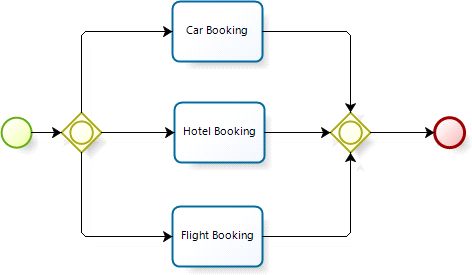Sub-Processes
Overview
A Sub-Process is a set of Activities that have a logical sequence that meet a clear purpose. A Sub-Process is a Process in itself, whose functionality is part of a larger Process. The larger process is known as the Parent process, and the Sub-Process itself is mentioned as the Child process.
When an instance of a Sub-Process is created, the child process inherits the parent process case number by default. This helps identify which Sub-Process belongs to which parent process. You can configure if the case number is inherited.
In Bizagi, Sub-Processes configuration is done as soon as a task is converted into a Sub-Process via the Sub-Process Configuration Wizard. This will be explained in detail in the following sections.
You can configure Sub-Processes as either Embedded or Reusable. Furthermore, they can be Transactional or Multiple, correspondingly:
| SUB-PROCESS | DESCRIPTION |
|---|---|
| Embedded | Embedded Sub-Processes can be configured as Transactional |
| Reusable | Reusable Sub-Processes can be configured as Multiple |
| Transactional | This Sub-Process is defined as Embedded |
| Multiple | This Sub-Process is defined as Reusable |
Sub-Process Properties
Sub-Process Type Considerations
| SUB-PROCESS TYPE | CONSIDERATIONS |
|---|---|
| Embedded Sub-Process | - Is a compound activity that contains other activities, gateways, events, etc., and is fully dependent on the parent process; it does not exist as a separate process. - It shares the same information or data with the parent process and can have a Transactional definition. - Embedded Processes are not meant to be reusable. - Cannot be configured as multiple Sub-Processes. - It can be set as a Transactional Sub-Process. |
Basic Properties
- Display Name: This is the display name of the Sub-Process that is shown in the Work Portal.
- Name: This is the name of the Sub-Process in the database. It cannot be modified.
- Description: Displays additional information for the Sub-Process.
Runtime Properties
- Duration: Determines the maximum time that a Sub-Process can be active (unfinished) to consider that it is still on time.
- Priority: Indicates the order in which Bizagi will activate or execute Sub-Processes.
- Is Asynchronous: Enables asynchronous behavior for the Sub-Process.
- Retries: Determines the number of times that the asynchronous task must be executed automatically if an error is thrown.
- Retry Interval: An interval of time in minutes that must be fulfilled before retrying the automatic execution of an asynchronous task in case of an error.
- Show Feedback: If enabled, the system will execute the Work Portal immediately and display a wait page while the request is processed. If disabled, the asynchronous task is executed later in the Bizagi scheduler, and the user is sent to the default page depending on the case.
- Timeout: Defines a maximum interval in seconds in which the execution of the asynchronous task is possible. The system automatically cancels the operation when the time is reached.
Transactional Sub-Process
- Error, Cancellation, and Compensation Events must be associated with a Transaction Process.
- It is defined as an Embedded Sub-Process.
Basic Properties
- Display Name: This is the display name of the Sub-Process that is shown in the Work Portal.
- Name: This is the name of the Sub-Process in the database.
- Description: Displays additional information for the Sub-Process.
Reusable Sub-Process
- Is an activity that references another process, independent of the parent process definition; it can be called from other process definitions.
- Reusable Sub-Processes can be defined as multiple Sub-Processes.
- This Sub-Process can be Integrated or Standalone:
- If Integrated is chosen, the parent Process continues when the Sub-Process is finished.
- If Standalone is chosen, the parent Process continues with the next Activity as soon as the Sub-Process is started.
- Reusable Sub-Processes cannot be transactional but can be configured as a Multiple Sub-Process.
Basic Properties
- Display Name: This is the display name of the Sub-Process that is shown in the Work Portal.
- Name: This is the name of the Sub-Process in the database.
- Description: Displays additional information for the Sub-Process.
Multiple Sub-Process
- Can be created as Sequential or Parallel.
- Parallel multiple Sub-Processes are identified by three vertical lines.
- Sequential multiple Sub-Processes are identified by three horizontal lines.
- It is defined as a Reusable Sub-Process.
Basic Properties
- Display Name: This is the display name of the Sub-Process that is shown in the Work Portal.
- Name: This is the name of the Sub-Process in the database.
- Description: Displays additional information for the Sub-Process.
Sub-Processes Representation
Sub-Processes can be represented in either an Expanded or Collapsed way.
Expanded Sub-Processes
When the Sub-Process is expanded, all its details can be seen within the limits.
In the following diagram, the Travel Request Process is depicted with an expanded Booking Sub-Process. The Activities within the Sub-Process are part of the main Process. This is a single Process represented in a single diagram.

Collapsed Sub-Processes
When the Sub-Process is collapsed, the details of the Sub-Process cannot be viewed. The plus sign (+) indicates that the shape is a Sub-Process and that it has a lower level of detail.
In the next diagram, the Travel Request Process is depicted with a collapsed Bookings Sub-Process.

The details of the Bookings Sub-Process are depicted in a separate diagram.

All Processes modeled in Bizagi are potential Sub-Processes.